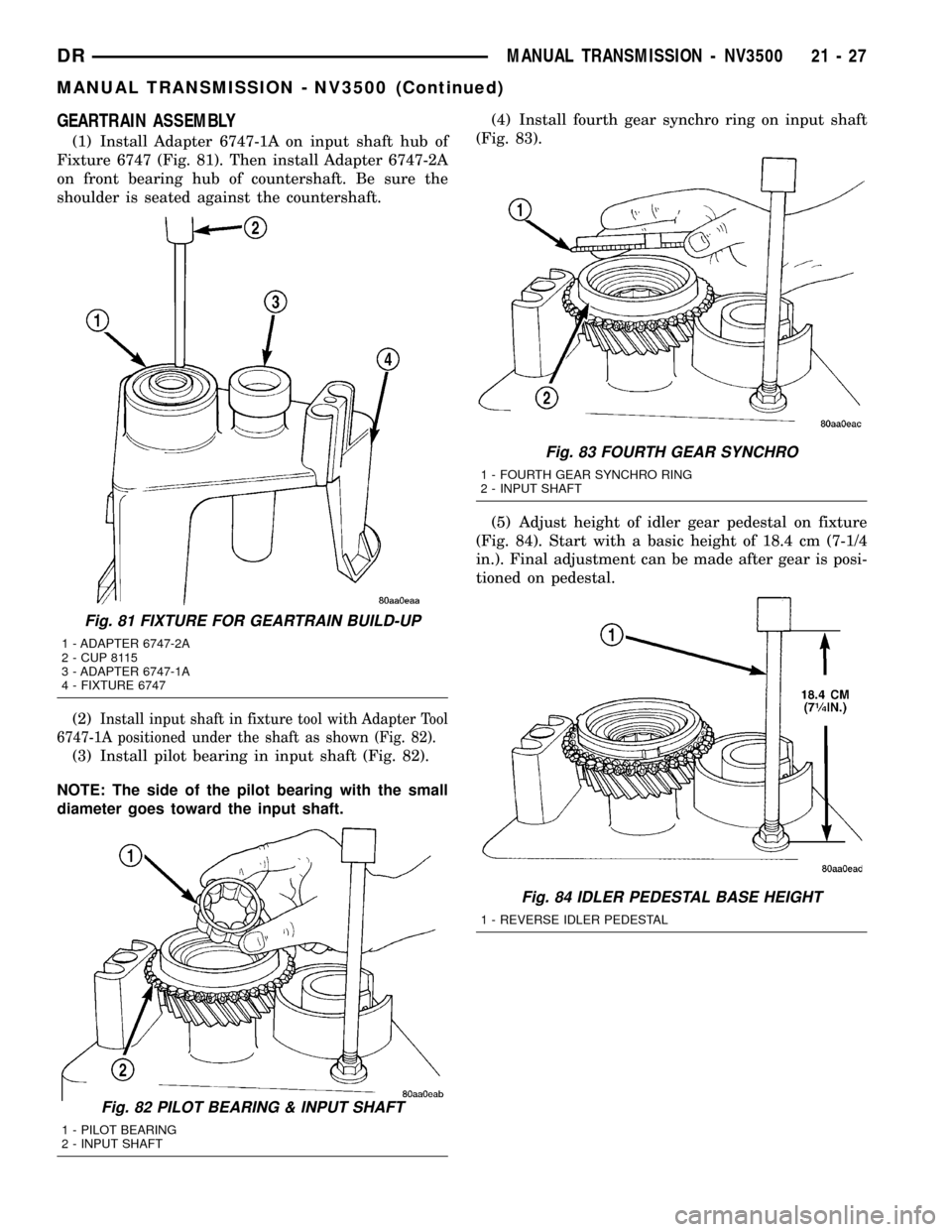1998 DODGE RAM 1500 height adjustment
[x] Cancel search: height adjustmentPage 252 of 2627

normal and should not be mistaken for contam-
ination.
(a) If fluid level is abnormally low, look for evi-
dence of leaks at calipers, wheel cylinders, brake
lines, and master cylinder.
(b) If fluid appears contaminated, drain out a
sample to examine. System will have to be flushed
if fluid is separated into layers, or contains a sub-
stance other than brake fluid. The system seals
and cups will also have to be replaced after flush-
ing. Use clean brake fluid to flush the system.
(4) Check parking brake operation. Verify free
movement and full release of cables and pedal. Also
note if vehicle was being operated with parking
brake partially applied.
(5) Check brake pedal operation. Verify that pedal
does not bind and has adequate free play. If pedal
lacks free play, check pedal and power booster for
being loose or for bind condition. Do not road test
until condition is corrected.
(6) Check booster vacuum check valve and hose.
(7) If components checked appear OK, road test
the vehicle.
ROAD TESTING
(1) If complaint involved low brake pedal, pump
pedal and note if it comes back up to normal height.
(2) Check brake pedal response with transmission
in Neutral and engine running. Pedal should remain
firm under constant foot pressure.
(3) During road test, make normal and firm brake
stops in 25-40 mph range. Note faulty brake opera-
tion such as low pedal, hard pedal, fade, pedal pulsa-
tion, pull, grab, drag, noise, etc.
(4) Attempt to stop the vehicle with the parking
brake only and note grab, drag, noise, etc.
PEDAL FALLS AWAY
A brake pedal that falls away under steady foot
pressure is generally the result of a system leak or
fluid contamination. The leak point could be at a
brake line, fitting, hose, or caliper/wheel cylinder. If
leakage is severe, fluid will be evident at or around
the leaking component.
Internal leakage (seal by-pass) in the master cylin-
der caused by worn or damaged piston cups, may
also be the problem cause.
An internal leak in the ABS or RWAL system may
also be the problem with no physical evidence.
LOW PEDAL
If a low pedal is experienced, pump the pedal sev-
eral times. If the pedal comes back up worn linings,
rotors, drums, or rear brakes out of adjustment are
the most likely causes. The proper course of action isto inspect and replace all worn component and make
the proper adjustments.
SPONGY PEDAL
A spongy pedal is most often caused by air in the
system. However, thin brake drums or substandard
brake lines and hoses can also cause a spongy pedal.
The proper course of action is to bleed the system,
and replace thin drums and substandard quality
brake hoses if suspected.
HARD PEDAL OR HIGH PEDAL EFFORT
A hard pedal or high pedal effort may be due to
lining that is water soaked, contaminated, glazed, or
badly worn. The power booster or check valve or a
vacuum hose could also be faulty.
PEDAL PULSATION
Pedal pulsation is caused by components that are
loose, or beyond tolerance limits.
The primary cause of pulsation are disc brake
rotors with excessive lateral runout or thickness vari-
ation, or out of round brake drums. Other causes are
loose wheel bearings or calipers and worn, damaged
tires.
NOTE: Some pedal pulsation may be felt during
ABS activation.
BRAKE DRAG
Brake drag occurs when the lining is in constant
contact with the rotor or drum. Drag can occur at one
wheel, all wheels, fronts only, or rears only.
Drag is a product of incomplete brake shoe release.
Drag can be minor or severe enough to overheat the
linings, rotors and drums.
Minor drag will usually cause slight surface char-
ring of the lining. It can also generate hard spots in
rotors and drums from the overheat-cool down pro-
cess. In most cases, the rotors, drums, wheels and
tires are quite warm to the touch after the vehicle is
stopped.
Severe drag can char the brake lining all the way
through. It can also distort and score rotors and
drums to the point of replacement. The wheels, tires
and brake components will be extremely hot. In
severe cases, the lining may generate smoke as it
chars from overheating.
Common causes of brake drag are:
²Seized or improperly adjusted parking brake
cables.
²Loose/worn wheel bearing.
²Seized caliper or wheel cylinder piston.
²Caliper binding on corroded bushings or rusted
slide surfaces.
²Loose caliper mounting.
DRBRAKES - BASE 5 - 3
BRAKES - BASE (Continued)
Page 1253 of 2627

TESTING VALVE SPRINGS
NOTE: Whenever the valves are removed from the
cylinder head it is recommended that the valve
springs be inspected and tested for reuse.
Inspect the valve springs for physical signs of wear or
damage. Turn table of tool C-647 until surface is in line
with the 40.12 mm (1.579 in.) mark on the threaded
stud and the zero mark on the front. Place spring over
the stud on the table and lift compressing lever to set
tone device. Pull on torque wrench until a Ping is
heard. Take reading on torque wrench at this instant.
Multiply this reading by two. This will give the spring
load at test length. Fractional measurements are indi-
cated on the table for finer adjustments. Refer to Spec-
ifications Section to obtain specified height and
allowable tensions. Replace any springs that do not
meet specifications (Fig. 19).
INSTALLATION
(1) coat the valve stem with clean engine oil and
insert it into the cylinder head.
(2) Install the valve stem seal. make sure the seal
is fully seated and that the garter spring at the top
of the seal is intact.
(3) Install the spring and the spring retainer (Fig.
20).
(4) Using the valve spring compressor, compress
the spring and install the two valve spring retainer
halves.
(5) Release the valve spring compressor and make
sure the two spring retainer halves and the spring
retainer are fully seated.
(6) lubricate the camshaft journal with clean
engine oil then Position the camshaft (with the
sprocket dowel on the left camshaft at 11 o'clock and
the right camshaft at 12 o'clock), then position the
camshaft bearing caps.(7) Install the camshaft bearing cap retaining
bolts. Tighten the bolts 9-13 N´m (100 in. lbs.) in 1/2
turn increments in the sequence shown (Fig. 21).
(8)
Position the hydraulic lash adjusters and rocker
arms(Refer to 9 - ENGINE/CYLINDER HEAD/ROCKER
ARM / ADJUSTER ASSY - INSTALLATION).
Fig. 19 Testing Valve Springs
1 - SPECIAL TOOL C-647
Fig. 20 Valve Assembly Configuration
1 - VALVE LOCKS (3±BEAD)
2 - RETAINER
3 - VALVE STEM OIL SEAL
4 - INTAKE VALVE
5 - EXHAUST VALVE
6 - VALVE SPRING
Fig. 21 Camshaft Bearing Caps Tightening
Sequence
9 - 30 ENGINE - 3.7LDR
INTAKE/EXHAUST VALVES & SEATS (Continued)
Page 1347 of 2627

REMOVAL
NOTE: The cylinder heads must be removed in
order to perform this procedure.
(1) Remove rocker arms and lash adjusters(Refer
to 9 - ENGINE/CYLINDER HEAD/ROCKER ARM /
ADJUSTER ASSY - REMOVAL). (Fig. 41).
(2) Remove the camshaft bearing caps and the
camshaft.
NOTE: All six valve springs and valves are removed
in the same manner; this procedure only covers
one valve and valve spring.
(3) Using Special Tool C-3422±B or C-3422±C
Valve Spring Compressor and Special tool 8519
Adapter, compress the valve spring.
NOTE: It may be necessary to tap the top of the
valve spring to loosen the spring retainers locks
enough to be removed.
(4) Remove the two spring retainer lock halves.
NOTE: the valve spring is under tension use care
when releasing the valve spring compressor.
(5) Remove the valve spring compressor.
(6) Remove the spring retainer, and the spring.NOTE: Check for sharp edges on the keeper
grooves. Remove any burrs from the valve stem
before removing the valve from the cylinder head.
(7) Remove the valve from the cylinder head.
NOTE: The valve stem seals are common between
intake and exhaust.
(8) Remove the valve stem seal. Mark the valve for
proper installation.
TESTING VALVE SPRINGS
NOTE: Whenever the valves are removed from the
cylinder head it is recommended that the valve
springs be inspected and tested for reuse.
Inspect the valve springs for physical signs of wear
or damage. Turn table of tool C-647 until surface is
in line with the 40.12 mm (1.579 in.) mark on the
threaded stud and the zero mark on the front. Place
spring over the stud on the table and lift compress-
ing lever to set tone device. Pull on torque wrench
until a Ping is heard. Take reading on torque wrench
at this instant. Multiply this reading by two. This
will give the spring load at test length. Fractional
measurements are indicated on the table for finer
adjustments. Refer to Specifications Section to obtain
specified height and allowable tensions. Replace any
springs that do not meet specifications (Fig. 42).
INSTALLATION
(1) coat the valve stem with clean engine oil and
insert it into the cylinder head.
(2) Install the valve stem seal. make sure the seal
is fully seated and that the garter spring at the top
of the seal is intact.
Fig. 41 Rocker Arm Removal
1 - CAMSHAFT
2 - SPECIAL TOOL 8516
Fig. 42 Testing Valve Springs
1 - SPECIAL TOOL C-647
9 - 124 ENGINE - 4.7LDR
INTAKE/EXHAUST VALVES & SEATS (Continued)
Page 1622 of 2627

(3) Check condition of relay terminals and PDC
connector terminals for damage or corrosion. Repair
if necessary before installing relay.
(4) Check for pin height (pin height should be the
same for all terminals within the PDC connector).
Repair if necessary before installing relay.
INSTALLATION
The fuel heater relay is located in the Power Dis-
tribution Center (PDC) (Fig. 6). Refer to label under
PDC cover for relay location.
(1) Install relay to PDC.
(2) Install cover to PDC.
FUEL INJECTION PUMP
DESCRIPTION
A Robert Bosch high-pressure fuel injection pump
is used. The pump is attached to the back of the tim-
ing gear cover at the left / rear side of the engine.
OPERATION
The fuel injection pump supplies high pressure to
the fuel rail independent of engine speed. This high
pressure is then accumulated in the fuel rail. High
pressure fuel is constantly supplied to the injectors
by the fuel rail. The Engine Control Module (ECM)
controls the fueling and timing of the engine by actu-
ating the injectors.
Fuel enters the system from the electric fuel trans-
fer (lift) pump, which is attached to the fuel filter
assembly. Fuel is forced through the fuel filter ele-
ment and then enters the Fuel Pump/Gear Pump,
which is attached to the rear of the fuel injection
pump. The Fuel Pump/Gear Pump is a low-pressure
pump and produce pressures ranging from 551.5 kpa
(80 psi) to 1241 kpa (180) psi. Fuel then enters the
fuel injection pump. Low pressure fuel is then sup-
plied to the FCA (Fuel Control Actuator).
The FCA is an electronically controlled solenoid
valve. The ECM controls the amount of fuel that
enters the high-pressure pumping chambers by open-
ing and closing the FCA based on a demanded fuel
pressure. The FPS (Fuel Pressure Sensor) on the fuel
rail provides the actual fuel pressure. When the
actuator is opened, the maximum amount of fuel is
being supplied to the fuel injection pump. Any fuel
that does not enter the injection pump is directed to
the cascade overflow valve. The cascade overflow
valve regulates how much excess fuel is used for
lubrication of the pump and how much is returned to
the tank through the drain manifold.
Fuel entering the injection pump is pressurized to
between 300-1600 bar (4351-23206 psi) by three
radial pumping chambers. The pressurized fuel is
then supplied to the fuel rail.
DIAGNOSIS AND TESTING - FUEL INJECTION
PUMP TIMING
With the Bosch injection pump, there are no
mechanical adjustments needed or necessary to
accomplish fuel injection timing. All timing and fuel
adjustments are electrically made by the engine
mounted Engine Control Module (ECM).
Fig. 6 POWER DISTRIBUTION CENTER LOCATION
1 - CLIP
2 - BATTERY
3 - TRAY
4 - NEGATIVE CABLE
5 - POSITIVE CABLE
6 - CLIP
7 - FENDER INNER SHIELD
8 - POWER DISTRIBUTION CENTER
DRFUEL DELIVERY - DIESEL 14 - 53
FUEL HEATER RELAY (Continued)
Page 1730 of 2627

GEARTRAIN ASSEMBLY
(1) Install Adapter 6747-1A on input shaft hub of
Fixture 6747 (Fig. 81). Then install Adapter 6747-2A
on front bearing hub of countershaft. Be sure the
shoulder is seated against the countershaft.
(2)
Install input shaft in fixture tool with Adapter Tool
6747-1A positioned under the shaft as shown (Fig. 82).
(3) Install pilot bearing in input shaft (Fig. 82).
NOTE: The side of the pilot bearing with the small
diameter goes toward the input shaft.(4) Install fourth gear synchro ring on input shaft
(Fig. 83).
(5) Adjust height of idler gear pedestal on fixture
(Fig. 84). Start with a basic height of 18.4 cm (7-1/4
in.). Final adjustment can be made after gear is posi-
tioned on pedestal.
Fig. 81 FIXTURE FOR GEARTRAIN BUILD-UP
1 - ADAPTER 6747-2A
2 - CUP 8115
3 - ADAPTER 6747-1A
4 - FIXTURE 6747
Fig. 82 PILOT BEARING & INPUT SHAFT
1 - PILOT BEARING
2 - INPUT SHAFT
Fig. 83 FOURTH GEAR SYNCHRO
1 - FOURTH GEAR SYNCHRO RING
2 - INPUT SHAFT
Fig. 84 IDLER PEDESTAL BASE HEIGHT
1 - REVERSE IDLER PEDESTAL
DRMANUAL TRANSMISSION - NV3500 21 - 27
MANUAL TRANSMISSION - NV3500 (Continued)
Page 2603 of 2627

HEATED SEAT MODULE - INSTALLATION . . . 8E-7
HEATED SEAT MODULE - INSTALLATION . . 8G-15
HEATED SEAT MODULE - OPERATION.....8E-6
HEATED SEAT MODULE - OPERATION....8G-14
HEATED SEAT MODULE - REMOVAL.......8E-7
HEATED SEAT MODULE - REMOVAL.....8G-15
HEATED SEAT SENSOR - DESCRIPTION . . . 8G-11
HEATED SEAT SENSOR - DIAGNOSIS
AND TESTING.......................8G-11
HEATED SEAT SENSOR - OPERATION....8G-11
HEATED SEAT SENSOR - REMOVAL......8G-11
HEATED SEAT SWITCH - DESCRIPTION . . . 8G-11
HEATED SEAT SWITCH - DIAGNOSIS
AND TESTING.......................8G-12
HEATED SEAT SWITCH - INSTALLATION . . 8G-13
HEATED SEAT SWITCH - OPERATION.....8G-12
HEATED SEAT SWITCH - REMOVAL......8G-13
HEATED SEAT SYSTEM - DESCRIPTION....8G-7
HEATED SEAT SYSTEM - DIAGNOSIS
AND TESTING........................8G-8
HEATED SEAT SYSTEM - OPERATION.....8G-8
HEATER - 5.9L DIESEL - DESCRIPTION,
ENGINE BLOCK.......................7-37
HEATER - 5.9L DIESEL - INSTALLATION,
ENGINE BLOCK.......................7-38
HEATER - 5.9L DIESEL - OPERATION,
ENGINE BLOCK.......................7-38
HEATER - 5.9L DIESEL - REMOVAL,
ENGINE BLOCK.........................7-38
HEATER - DESCRIPTION, ENGINE BLOCK . . . 7-36
HEATER - DESCRIPTION, FUEL..........14-51
HEATER - DESCRIPTION, INTAKE AIR.....14-80
HEATER - DIAGNOSIS AND TESTING,
ENGINE BLOCK.......................7-36
HEATER - DIAGNOSIS AND TESTING,
FUEL..............................14-52
HEATER - INSTALLATION, ENGINE
BLOCK..............................7-37
HEATER - INSTALLATION, INTAKE AIR....14-80
HEATER - OPERATION, ENGINE BLOCK....7-36
HEATER - OPERATION, FUEL............14-51
HEATER - OPERATION, INTAKE AIR......14-80
HEATER - REMOVAL, ENGINE BLOCK......7-37
HEATER - REMOVAL, INTAKE AIR........14-80
HEATER AND AIR CONDITIONER -
DESCRIPTION........................24-1
HEATER AND AIR CONDITIONER -
OPERATION..........................24-1
HEATER CONTROL - DESCRIPTION, A/C . . . 24-14
HEATER CONTROL - INSTALLATION, A/C . . 24-15
HEATER CONTROL - REMOVAL, A/C......24-15
HEATER CORE - DESCRIPTION..........24-63
HEATER CORE - INSTALLATION.........24-63
HEATER CORE - OPERATION............24-63
HEATER CORE - REMOVAL.............24-63
HEATER INLET HOSE - INSTALLATION....24-64
HEATER INLET HOSE - REMOVAL........24-64
HEATER PERFORMANCE TEST -
DIAGNOSIS AND TESTING..............24-6
HEATER RELAY - DESCRIPTION, FUEL....14-52
HEATER RELAY - DESCRIPTION, INTAKE
AIR ...............................14-82
HEATER RELAY - INSTALLATION, FUEL . . . 14-53
HEATER RELAY - INSTALLATION, INTAKE
AIR ...............................14-82
HEATER RELAY - OPERATION, FUEL......14-52
HEATER RELAY - OPERATION, INTAKE
AIR ...............................14-82
HEATER RELAY - REMOVAL, FUEL.......14-52
HEATER RELAY - REMOVAL, INTAKE AIR . . 14-82
HEATER RETURN HOSE - INSTALLATION . . 24-65
HEATER RETURN HOSE - REMOVAL......24-64
HEIGHT ADJUSTMENT - 4WD (LD) -
STANDARD PROCEDURE.................2-3
HEIGHT MEASUREMENT - 4WD (LD) -
STANDARD PROCEDURE.................2-3
HEMI ENGINE - INSTALLATION, 3.7L/4.7L
AND 5.7L......................24-59,24-73
HEMI ENGINE - REMOVAL, 3.7L/4.7L
AND 5.7L......................24-57,24-71
HIGH BEAM INDICATOR - DESCRIPTION
. . 8J-28
HIGH BEAM INDICATOR - OPERATION
....8J-28
HIGH MOUNTED STOP LAMP -
INSTALLATION, CENTER
...............8L-11
HIGH MOUNTED STOP LAMP -
REMOVAL, CENTER
...................8L-11
HIGH MOUNTED STOP LAMP UNIT -
INSTALLATION, CENTER
...............8L-11HIGH MOUNTED STOP LAMP UNIT -
REMOVAL, CENTER...................8L-11
HIGH PRESSURE RELIEF VALVE -
DESCRIPTION.......................24-48
HIGH PRESSURE RELIEF VALVE -
OPERATION.........................24-48
HIGH SPEEDS - DESCRIPTION, TIRE
PRESSURE..........................22-7
HIGH/LOW RELAY - DESCRIPTION,
WIPER.............................8R-20
HIGH/LOW RELAY - DIAGNOSIS AND
TESTING, WIPER.....................8R-21
HIGH/LOW RELAY - INSTALLATION,
WIPER.............................8R-22
HIGH/LOW RELAY - OPERATION, WIPER . . 8R-20
HIGH/LOW RELAY - REMOVAL, WIPER . . . 8R-21
HIGH-PRESSURE FUEL LINE LEAKS -
DIAGNOSIS AND TESTING.............14-58
HINGE - INSTALLATION.....23-16,23-22,23-31,
23-46
HINGE - INSTALLATION, CENTER SEAT
BACK..............................23-79
HINGE - REMOVAL....23-16,23-22,23-31,23-46
HINGE - REMOVAL, CENTER SEAT BACK . . 23-78
HINGE COVER - INSTALLATION, CENTER
SEAT BACK INERTIA..................23-77
HINGE COVER - REMOVAL, CENTER
SEAT BACK INERTIA..................23-77
HITCH - INSTALLATION, TRAILER........13-25
HITCH - REMOVAL, TRAILER...........13-25
HOAT COOLANT - DESCRIPTION..........7-32
HOISTING - STANDARD PROCEDURE......0-20
HOLDDOWN - DESCRIPTION, BATTERY . . . 8F-14
HOLDDOWN - INSTALLATION, BATTERY . . . 8F-14
HOLDDOWN - OPERATION, BATTERY.....8F-14
HOLDDOWN - REMOVAL, BATTERY......8F-14
HOLDER - INSTALLATION, CUP.........23-51
HOLDER - REMOVAL, CUP.............23-51
HOLDING CLUTCHES - DESCRIPTION....21-371
HOLDING CLUTCHES - OPERATION.....21-372
HOLE PLUG - INSTALLATION, CAMSHAFT
CORE..............................9-206
HOLE PLUG - REMOVAL, CAMSHAFT
CORE..............................9-205
HOLE REPAIR - DESCRIPTION,
THREADED........................Intro.-8
HONING - STANDARD PROCEDURE,
CYLINDER BORE.................9-128,9-38
HOOD - INSTALLATION................23-47
HOOD - REMOVAL....................23-46
HOOK - INSTALLATION, COAT...........23-66
HOOK - REMOVAL, COAT..............23-66
HOOK ASSEMBLY - INSTALLATION,
FRONT TOW........................13-23
HOOK ASSEMBLY - REMOVAL, FRONT
TOW ..............................13-23
HORN - DIAGNOSIS AND TESTING.......8H-1
HORN - INSTALLATION.................8H-2
HORN - REMOVAL....................8H-2
HORN SWITCH - DESCRIPTION..........8H-2
HORN SWITCH - DIAGNOSIS AND
TESTING............................8H-2
HORN SYSTEM - DESCRIPTION..........8H-1
HORN SYSTEM - DIAGNOSIS AND
TESTING............................8H-1
HORN SYSTEM - OPERATION............8H-1
HOSE - GEAR TO COOLER -
INSTALLATION, RETURN..........19-44,19-45
HOSE - GEAR TO COOLER - REMOVAL,
RETURN......................19-44,19-45
HOSE - INSTALLATION, FRONT BRAKE.....5-13
HOSE - INSTALLATION, HEATER INLET....24-64
HOSE - INSTALLATION, HEATER RETURN . 24-65
HOSE - INSTALLATION, PRESSURE . 19-44,19-45
HOSE - INSTALLATION, REAR BRAKE......5-12
HOSE - REMOVAL, FRONT..............5-12
HOSE - REMOVAL, HEATER INLET.......24-64
HOSE - REMOVAL, HEATER RETURN.....24-64
HOSE - REMOVAL, PRESSURE.....19-44,19-45
HOSE - REMOVAL, REAR BRAKE
.........5-11
HOSE - RESERVOIR TO COOLER -
INSTALLATION, RETURN
..........19-44,19-45
HOSE - RESERVOIR TO COOLER -
REMOVAL, RETURN
.............19-44,19-45
HOSE ASSEMBLY - INSTALLATION, REAR
TUBE
...............................5-13
HOSE ASSEMBLY - REMOVAL, REAR
TUBE
...............................5-12HOSE CLAMPS - DESCRIPTION...........7-3
HOSE CLAMPS - OPERATION.............7-5
HOSES/TUBES - DESCRIPTION, WASHER . 8R-11
HOSES/TUBES - OPERATION, WASHER . . . 8R-11
HOUSING - ASSEMBLY, HVAC...........24-35
HOUSING - DIAGNOSIS AND TESTING,
CLUTCH..............................6-7
HOUSING - DISASSEMBLY, HVAC........24-35
HOUSING - INSTALLATION, CLUTCH.......6-9
HOUSING - INSTALLATION, GEAR........9-300
HOUSING - INSTALLATION, HVAC........24-36
HOUSING - INSTALLATION, ROCKER.....9-255
HOUSING - REMOVAL, CLUTCH...........6-9
HOUSING - REMOVAL, GEAR...........9-299
HOUSING - REMOVAL, HVAC...........24-34
HOUSING - REMOVAL, ROCKER.........9-255
HOUSING BUSHING AND SEAL -
INSTALLATION, EXTENSION...........21-440
HOUSING BUSHING AND SEAL -
REMOVAL, EXTENSION...............21-440
HOUSING COVER - INSTALLATION, GEAR . 9-301
HOUSING COVER - REMOVAL, GEAR.....9-301
HOUSING FLUID LEAK - DIAGNOSIS AND
TESTING, CONVERTER.........21-144,21-318
HOUSING SEAL - INSTALLATION,
ADAPTER...............21-128,21-364,21-85
HOUSING SEAL - INSTALLATION,
EXTENSION . 21-128,21-201,21-507,21-536,21-85
HOUSING SEAL - REMOVAL, ADAPTER . . 21-128,
21-364,21-85
HOUSING SEAL - REMOVAL,
EXTENSION . 21-128,21-201,21-507,21-536,21-85
HOUSING SEAL AND DUST BOOT -
INSTALLATION, EXTENSION.....21-476,21-571
HOUSING SEAL AND DUST BOOT -
REMOVAL, EXTENSION.........21-476,21-571
HOW TO USE WIRING DIAGRAMS -
DESCRIPTION.....................8W-01-1
H-SECTION REPLACEMENT - STANDARD
PROCEDURE, REAR FRAME............13-13
HUB / BEARING - INSTALLATION.........2-32
HUB / BEARING - REMOVAL.............2-31
HVAC HOUSING - ASSEMBLY...........24-35
HVAC HOUSING - DISASSEMBLY........24-35
HVAC HOUSING - INSTALLATION........24-36
HVAC HOUSING - REMOVAL............24-34
HYDRAULIC BOOSTER - DIAGNOSIS
AND TESTING........................5-30
HYDRAULIC LASH ADJUSTER -
DIAGNOSIS AND TESTING.........9-125,9-32
HYDRAULIC PRESSURE TEST -
DIAGNOSIS AND TESTING......21-141,21-316
HYDRAULIC SCHEMATICS, SCHEMATICS
AND DIAGRAMS..............21-176,21-337
HYDRAULIC TAPPETS - DIAGNOSIS AND
TESTING...........................9-210
HYDRAULIC TAPPETS - INSTALLATION . . . 9-211
HYDRAULIC TAPPETS - REMOVAL.......9-211
HYDROBOOST - INSTALLATION..........5-27
HYDROBOOST - INSTALLATION, ALL
EXCEPT.............................5-27
HYDROBOOST - REMOVAL..............5-26
HYDROBOOST - REMOVAL, ALL EXCEPT . . . 5-26
HYDRO-BOOST BRAKE BOOSTER -
INSTALLATION........................5-32
HYDRO-BOOST BRAKE BOOSTER -
REMOVAL
...........................5-31
HYDROFORM FENDER RAIL REPAIR -
STANDARD PROCEDURE
...............13-11
HYDROSTATIC LOCK - STANDARD
PROCEDURE
...................9-190,9-240
IDENTIFICATION - DESCRIPTION,
FASTENER
.........................Intro.-5
IDENTIFICATION AND INFORMATION -
DESCRIPTION, SECTION
.............8W-01-6
IDENTIFICATION NUMBER -
DESCRIPTION, VEHICLE
..............Intro.-1
IDLE AIR CONTROL MOTOR -
DESCRIPTION
.......................14-28
IDLE AIR CONTROL MOTOR -
INSTALLATION
.......................14-29
IDLE AIR CONTROL MOTOR -
OPERATION
.........................14-28
IDLE AIR CONTROL MOTOR - REMOVAL
. . 14-29
IDLER SHAFT - INSTALLATION
......9-179,9-81
IDLER SHAFT - REMOVAL
..........9-179,9-81
IGNITION - SPECIFICATIONS, TORQUE
.....8I-3
16 INDEXDR
Description Group-Page Description Group-Page Description Group-Page